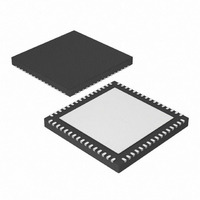DSPIC33FJ64GS406-E/MR Microchip Technology, DSPIC33FJ64GS406-E/MR Datasheet - Page 123

DSPIC33FJ64GS406-E/MR
Manufacturer Part Number
DSPIC33FJ64GS406-E/MR
Description
MCU/DSP 16BIT 64KB FLASH 64QFN
Manufacturer
Microchip Technology
Series
dsPIC™ 33Fr
Datasheet
1.DSPIC33FJ32GS406-IPT.pdf
(418 pages)
Specifications of DSPIC33FJ64GS406-E/MR
Program Memory Type
FLASH
Program Memory Size
64KB (64K x 8)
Package / Case
64-VQFN
Core Processor
dsPIC
Core Size
16-Bit
Speed
40 MIPs
Connectivity
I²C, IrDA, LIN, SCI, SPI, UART/USART, USB
Peripherals
Brown-out Detect/Reset, QEI, POR, PWM, WDT
Number Of I /o
58
Ram Size
8K x 8
Voltage - Supply (vcc/vdd)
3 V ~ 3.6 V
Data Converters
A/D 16x10b
Oscillator Type
Internal
Operating Temperature
-40°C ~ 125°C
Product
DSCs
Data Bus Width
16 bit
Processor Series
DSPIC33F
Core
dsPIC
Numeric And Arithmetic Format
Fixed-Point or Floating-Point
Instruction Set Architecture
Harvard
Device Million Instructions Per Second
40 MIPs
Maximum Clock Frequency
120 MHz
Number Of Programmable I/os
58
Data Ram Size
4 KB
Operating Supply Voltage
3.3 V
Maximum Operating Temperature
+ 125 C
Mounting Style
SMD/SMT
3rd Party Development Tools
52713-733, 52714-737, 53276-922, EWDSPIC
Development Tools By Supplier
PG164130, DV164035, DV244005, DV164005, PG164120, DM240001, DV164033
Interface Type
I2C, SPI, UART
Minimum Operating Temperature
- 40 C
On-chip Adc
10 bit, 16 Channel
Lead Free Status / RoHS Status
Lead free / RoHS Compliant
Eeprom Size
-
Lead Free Status / Rohs Status
Lead free / RoHS Compliant
- Current page: 123 of 418
- Download datasheet (3Mb)
7.0
The
dsPIC33FJ64GS406/606/608/610 interrupt controller
reduces the numerous peripheral interrupt request
signals to a single interrupt request signal to the
dsPIC33FJ32GS406/606/608/610
dsPIC33FJ64GS406/606/608/610 CPU. It has the
following features:
• Up to eight processor exceptions and software
• Seven user-selectable priority levels
• Interrupt Vector Table (IVT) with up to 118 vectors
• A unique vector for each interrupt or exception
• Fixed priority within a specified user priority level
• Alternate Interrupt Vector Table (AIVT) for debug
• Fixed interrupt entry and return latencies
7.1
The Interrupt Vector Table (IVT) is shown in Figure 7-1.
The IVT resides in program memory, starting at location
000004h. The IVT contains 126 vectors, consisting of
eight nonmaskable trap vectors, plus up to 118 sources
of interrupt. In general, each interrupt source has its own
vector. Each interrupt vector contains a 24-bit-wide
address. The value programmed into each interrupt
vector location is the starting address of the associated
Interrupt Service Routine (ISR).
2010 Microchip Technology Inc.
traps
source
support
dsPIC33FJ32GS406/606/608/610 and dsPIC33FJ64GS406/606/608/610
Note 1: This data sheet summarizes the features
2: Some registers and associated bits
INTERRUPT CONTROLLER
Interrupt Vector Table
dsPIC33FJ32GS406/606/608/610
of the dsPIC33FJ32GS406/606/608/610
and
families of devices. It is not intended to be
a comprehensive reference source. To
complement the information in this data
sheet, refer to Section 47. “Interrupts
(Part V)” (DS70597) in the “dsPIC33F/
PIC24H
which is available from the Microchip web
site (www.microchip.com).
described in this section may not be avail-
able on all devices. Refer to Section 4.0
“Memory Organization” in this data
sheet for device-specific register and bit
information.
dsPIC33FJ64GS406/606/608/610
Family
Reference
Manual”,
and
and
Preliminary
Interrupt vectors are prioritized in terms of their natural
priority. This priority is linked to their position in the
vector table. Lower addresses generally have a higher
natural priority. For example, the interrupt associated
with vector 0 will take priority over interrupts at any
other vector address.
The
dsPIC33FJ64GS406/606/608/610 devices implement up
to 71 unique interrupts and five non-maskable traps.
These are summarized in Table 7-1.
7.1.1
The Alternate Interrupt Vector Table (AIVT) is located
after the IVT, as shown in Figure 7-1. Access to the
AIVT
(INTCON2<15>). If the ALTIVT bit is set, all interrupt
and exception processes use the alternate vectors
instead of the default vectors. The alternate vectors are
organized in the same manner as the default vectors.
The AIVT supports debugging by providing a means to
switch between an application and a support
environment without requiring the interrupt vectors to
be reprogrammed. This feature also enables switching
between applications for evaluation of different
software algorithms at run time. If the AIVT is not
needed, the AIVT should be programmed with the
same addresses used in the IVT.
7.2
A device Reset is not a true exception because the
interrupt controller is not involved in the Reset process.
The
dsPIC33FJ64GS406/606/608/610
registers in response to a Reset, which forces the PC to
zero. The digital signal controller then begins program
execution at location 0x000000. A GOTO instruction at the
Reset address can redirect program execution to the
appropriate start-up routine.
Note:
is
Reset Sequence
dsPIC33FJ32GS406/606/608/610
dsPIC33FJ32GS406/606/608/610
provided
ALTERNATE INTERRUPT VECTOR
TABLE
Any unimplemented or unused vector
locations in the IVT and AIVT should be
programmed with the address of a default
interrupt handler routine that contains a
RESET instruction.
by
the
ALTIVT
device
DS70591C-page 123
control
clears
and
and
bit
its
Related parts for DSPIC33FJ64GS406-E/MR
Image
Part Number
Description
Manufacturer
Datasheet
Request
R

Part Number:
Description:
IC, DSC, 16BIT, 12KB, 40MHZ, 3.6V, DIP28
Manufacturer:
Microchip Technology
Datasheet:

Part Number:
Description:
Manufacturer:
Microchip Technology Inc.
Datasheet:

Part Number:
Description:
Manufacturer:
Microchip Technology Inc.
Datasheet:

Part Number:
Description:
Manufacturer:
Microchip Technology Inc.
Datasheet:

Part Number:
Description:
Manufacturer:
Microchip Technology Inc.
Datasheet:

Part Number:
Description:
Manufacturer:
Microchip Technology Inc.
Datasheet:

Part Number:
Description:
Manufacturer:
Microchip Technology Inc.
Datasheet:

Part Number:
Description:
Manufacturer:
Microchip Technology Inc.
Datasheet:

Part Number:
Description:
Manufacturer:
Microchip Technology Inc.
Datasheet:










